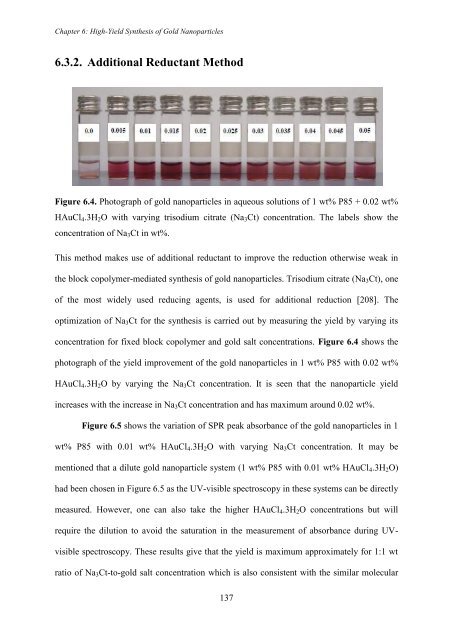PHYS01200704032 Debes Ray - Homi Bhabha National Institute
PHYS01200704032 Debes Ray - Homi Bhabha National Institute
PHYS01200704032 Debes Ray - Homi Bhabha National Institute
You also want an ePaper? Increase the reach of your titles
YUMPU automatically turns print PDFs into web optimized ePapers that Google loves.
Chapter 6: High-Yield Synthesis of Gold Nanoparticles<br />
6.3.2. Additional Reductant Method<br />
Figure 6.4. Photograph of gold nanoparticles in aqueous solutions of 1 wt% P85 + 0.02 wt%<br />
HAuCl 4 .3H 2 O with varying trisodium citrate (Na 3 Ct) concentration. The labels show the<br />
concentration of Na 3 Ct in wt%.<br />
This method makes use of additional reductant to improve the reduction otherwise weak in<br />
the block copolymer-mediated synthesis of gold nanoparticles. Trisodium citrate (Na 3 Ct), one<br />
of the most widely used reducing agents, is used for additional reduction [208]. The<br />
optimization of Na 3 Ct for the synthesis is carried out by measuring the yield by varying its<br />
concentration for fixed block copolymer and gold salt concentrations. Figure 6.4 shows the<br />
photograph of the yield improvement of the gold nanoparticles in 1 wt% P85 with 0.02 wt%<br />
HAuCl 4 .3H 2 O by varying the Na 3 Ct concentration. It is seen that the nanoparticle yield<br />
increases with the increase in Na 3 Ct concentration and has maximum around 0.02 wt%.<br />
Figure 6.5 shows the variation of SPR peak absorbance of the gold nanoparticles in 1<br />
wt% P85 with 0.01 wt% HAuCl 4 .3H 2 O with varying Na 3 Ct concentration. It may be<br />
mentioned that a dilute gold nanoparticle system (1 wt% P85 with 0.01 wt% HAuCl 4 .3H 2 O)<br />
had been chosen in Figure 6.5 as the UV-visible spectroscopy in these systems can be directly<br />
measured. However, one can also take the higher HAuCl 4 .3H 2 O concentrations but will<br />
require the dilution to avoid the saturation in the measurement of absorbance during UVvisible<br />
spectroscopy. These results give that the yield is maximum approximately for 1:1 wt<br />
ratio of Na 3 Ct-to-gold salt concentration which is also consistent with the similar molecular<br />
137

















